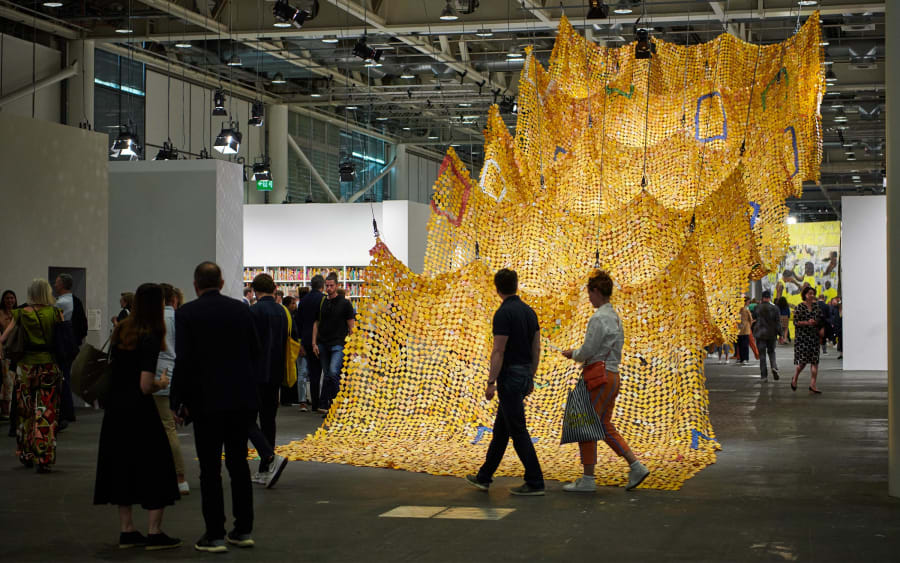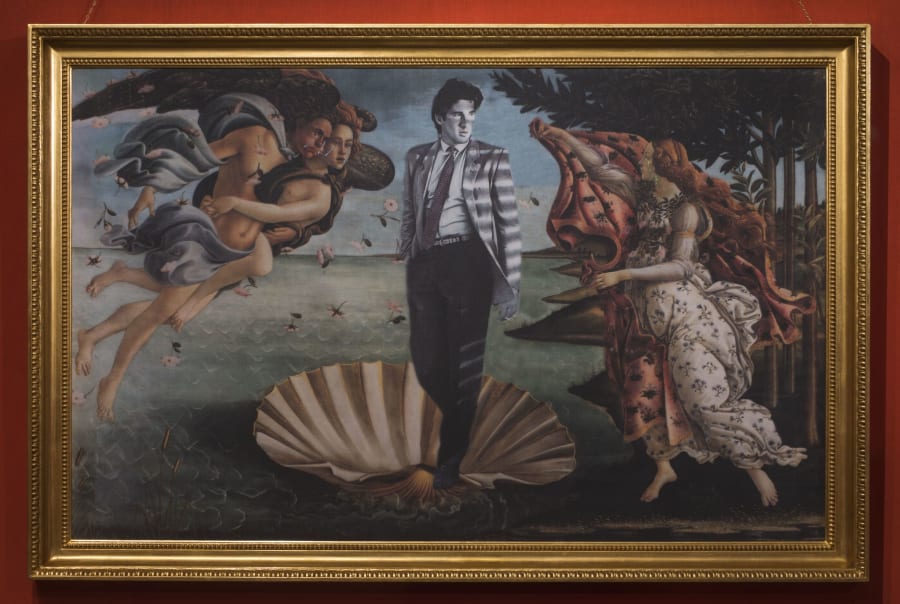‘It was actually at quite a late point that I realized I was becoming an artist. After studying photography in Denmark, I moved to London in 2002 to do this very short-lived course at London’s Royal College of Art called Communication in Art and Design. The curriculum was meant to encourage us to develop a practice outside of established media, but it was a strange, limbo-like space, where it wasn’t quite clear what we were working toward. I started collaborating with my friend Marie Lund, documenting social experiments and devising mini-choreographies based on testing group dynamics in different ways – like asking a disbanded political collective to keep their eyes closed for as long as they could, or the members of an extended family to walk as far into the ocean as each of them dared.
‘At one point, a friend of ours who had started a project space in our house took some of our videos to the Zoo Art Fair. There, the curator Catherine Wood from Tate Modern saw them and invited us to do a performance in the Turbine Hall. Since we hadn’t really studied with other artists, we weren’t part of a scene, so when she wrote to us to arrange a studio visit, we didn’t even know what that was. And that was how our work first found its way into the art institution.
‘Recently, when I told the curator Cédric Fauq at the CAPC in Bordeaux about my background in photography, he said: “Of course! Because you never make anything up, you just point your lens to things that already exist.” I hadn’t made that connection, but I know I often use photographic terms when talking about my work, like “zooming in.” I always look for the type of object that is a kind of representation of itself, something that sits between object and image, creating a disturbing effect – like a broken camera with a lens that can’t stay focused. An actor’s tear, for instance, is both real and artificial; a fake designer handbag is both a real bag and a representation of a bag, etc. Once you start to look out for it, you’ll notice that a lot of objects are basically readymade sculptures.
‘For me, the transition to making sculpture came gradually as a kind of side effect to the experiments in the videos. In one work, Marie and I built a wooden box to fit exactly around the duplicate books my mother had kept in the attic since my parents moved in together. These were works of classic literature, like Mao’s Little Red Book [1964], which felt like a portrait of that time, and of the culture my parents shared. The premise was that, if they ever split up and she needed the books back, the box alone would be the work. So, although there was a sculptural element, it was still a kind of social object. To this day, I don’t really distinguish between sculpture and performance in my practice.
‘I moved to Berlin in 2008 and began working on my own. In that process, my interest shifted to thinking about social contracts and power on a more structural level. As a child, my parents worked for a Scandinavian development aid organization, so we moved back and forth between Denmark and Mozambique. I think seeing the world from two very different perspectives at the same time in that way had a lot to do with me taking up that interest later on.
‘In one of the first works I did during this period, I collected clothes with animal prints and framed them so that, when pressed against the glass, they created an abstract pattern. When I lived in Mozambique, a load of donated clothes would arrive in our neighborhood every few months, and all the kids would run up and find sweatshirts from some Norwegian sports club, stone-washed jeans or a pair of leopard-print tights. This work might have marked the beginning of my obsession with how the circulation of objects shapes how we perceive them. The idea of leopard print arriving in a country where the leopard is a native animal from one where it’s not – and all the financial and geopolitical agendas that are woven into the fabric along the way – fascinates me.
‘I think I work with found objects because I distrust intentional expression as such. It’s another thing I got from my experience of growing up with my parents and their friends working in the field of development aid. Even though they came to Mozambique with the best of intentions, a lot of projects failed due to a lack of understanding of different cultures and economies. It fostered in me this fundamental sense of relativity, the idea that neither I, nor anyone else, should be in a position to tell other people how the world works. My biggest fear as an artist is that I become a didactic preacher of right and wrong.
‘Instead, I am trying to make the objects themselves speak to the variety of human intentions that formed their history, as testaments to the global machinery and the people who produced them. Objects are often perceived as mute, but I find that, by bringing them into formal conversations with other objects, they can be made to reveal their stories in subtle and complex ways. I definitely don’t want to be the narrator, so I try to leave these stories open, both in the sense that my interventions can often be undone – a bathroom sink can return to being a bathroom sink and a cigar can return to being a cigar – and in that the signification of the object continues to evolve and fluctuate even after it has become part of a sculpture.’
Nina Beier is represented by Croy Nielsen (Vienna) and Standard (Oslo) (Oslo).
Current and upcoming solo exhibitions include ‘Auto’ at CAPC, Bordeaux, from March 3 to September 8, 2024; ‘Parts’ at the Museum of Contemporary Art Kiasma, Helsinki, from March 22 to September 8, 2024; and ‘Casts’ at Tamayo, Mexico City, from May 24 to September 29, 2024. Beier’s work is currently on view in the group exhibitions ‘A Model’ (with Bob Kil) at MUDAM, Luxemburg, until September 8, 2024; and ‘Coming Soon’ at Lafayette Anticipations, Paris, until May 12, 2024.
Kristian Vistrup Madsen is a writer, art critic, and curator based in Berlin. His work has been published in magazines including Artforum, frieze, Mousse, and The White Review. His book Doing Time: Essays on Using People was published by Floating Opera Press in 2021.
Caption for top image: Nina Beier, Guardians (detail), 2022. Installation view at Paris+ par Art Basel, Jardin des Tuileries, Paris, 2023. Photograph by Dawn Blackman. Courtesy of the artist, Croy Nielsen, and Standard.
Published on April 30, 2024.


